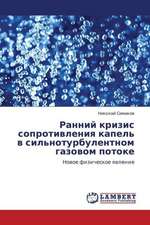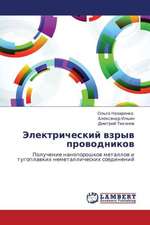Pinch Analysis for Energy and Carbon Footprint Reduction: User Guide to Process Integration for the Efficient Use of Energy
Autor Ian C. Kemp, Jeng Shiun Limen Limba Engleză Paperback – 5 aug 2020
This new edition offers tips and techniques for practical applications, supported by several detailed case studies. Examples stem from a wide range of industries, including buildings and other non-process situations. This reference is a must-have guide for chemical process engineers, food and biochemical engineers, plant engineers, and professionals concerned with energy optimization, including building designers.
- Covers practical analysis of both new and existing processes
- Teaches readers to extract the stream data necessary for a pinch analysis and describes the targeting process in depth; includes a downloadable spreadsheet to calculate energy targets
- Demonstrates how to achieve the targets by heat recovery, utility system design, and process change
- Updated to include carbon footprint, water and hydrogen pinch, developments in industrial applications and software, site data reconciliation, additional case studies, and answers to selected exercises
Preț: 553.79 lei
Preț vechi: 767.37 lei
-28% Nou
Puncte Express: 831
Preț estimativ în valută:
105.96€ • 110.64$ • 87.70£
105.96€ • 110.64$ • 87.70£
Carte tipărită la comandă
Livrare economică 28 martie-11 aprilie
Preluare comenzi: 021 569.72.76
Specificații
ISBN-13: 9780081025369
ISBN-10: 008102536X
Pagini: 566
Dimensiuni: 191 x 235 x 33 mm
Greutate: 0.96 kg
Ediția:3
Editura: ELSEVIER SCIENCE
ISBN-10: 008102536X
Pagini: 566
Dimensiuni: 191 x 235 x 33 mm
Greutate: 0.96 kg
Ediția:3
Editura: ELSEVIER SCIENCE
Public țintă
Chemical and process engineers; graduate students; students undertaking capstone projects in process design. Key user groups include bulk/batch chemicals, oil/gas, food/drink/consumer products, buildings design and combined heat and power applicationsCuprins
1. Introduction
1.1 What is pinch analysis?
1.2 Historical development and industrial experience
1.3 Why does pinch analysis work?
1.4 The concept of process synthesis
1.5 Hierarchy of energy reduction
1.6 The role of thermodynamics in process design
1.7 Learning and applying the techniques
1.8 A note on terminology
2. Carbon footprint and primary energy
2.1 Introduction
2.2 Definition of carbon footprint
2.3 Primary energy
2.4 Carbon dioxide emissions and carbon footprint
2.5 Components of carbon footprint
2.6 Carbon pinch and emissions targeting
2.7 Energy costs
2.8 Conclusions
3. Key concepts of pinch analysis
3.1 Heat recovery and heat exchange
3.2 The pinch and its significance
3.3 Heat exchanger network design
3.4 Choosing ΔTmin: supertargeting
3.5 Methodology of pinch analysis
3.6 Worked exercise
4. Data extraction and energy targeting
4.1 Data extraction
4.2 Case study - organics distillation plant
4.3 Energy targeting
4.4 Multiple utilities
4.5 More advanced energy targeting
4.6 Targeting heat exchange units, area and shells
4.7 Supertargeting; cost targeting for optimal ΔTmin
4.8 Targeting for organics distillation plant case study
4.9 Exercises
Appendix – Algorithms for Problem Table and composite curves
5. Heat exchanger network design
5.1 Introduction
5.2 Heat exchange equipment
5.3 Stream splitting and cyclic matching
5.4 Network relaxation
5.5 More complex designs
5.6 Multiple pinches and near-pinches
5.7 Retrofit design
5.8 Operability; multiple base case design
5.9 Network design for organics distillation case study
5.10 Conclusions
5.11 Exercises
6. Utilities, heat and power systems
6.1 Concepts
6.2 Combined heat and power systems
6.3 Heat pumps and refrigeration systems
6.4 Total site analysis
6.5 Worked example – organics distillation unit
6.6 Worked case study and example for total site problem table algorithm
6.7 Case studies and examples
6.8 Exercises
7. Process change and evolution
7.1 Concepts
7.2 General principles
7.3 Reactor systems
7.4 Distillation columns
7.5 Evaporator systems
7.6 Flash systems
7.7 Solids drying
7.8 Other separation methods
7.9 Application to the organics distillation process case study
7.10 Summary and conclusions
7.11 Exercises
8. Batch and time-dependent processes
8.1 Introduction
8.2 Concepts
8.3 Types of streams in batch processes
8.4 Time intervals
8.5 Calculating energy targets
8.6 Heat exchanger network design
8.7 Rescheduling
8.8 Debottlenecking
8.9 Other time-dependent applications
8.10 Conclusions
9. Water, hydrogen, and carbon pinch
9.1 Introduction
9.2 Concepts
9.3 Key steps in mass pinch analysis
9.4 Application and case study for water pinch analysis (Glove Industry)
9.5 Application and case study for hydrogen pinch analysis
9.6 Conclusions for water and hydrogen pinch analysis
9.7 Carbon pinch
10. Applying the technology in practice
10.1 Introduction
10.2 How to do a pinch study
10.3 Heat and mass balance
10.4 Stream data extraction
10.5 Targeting and network design
10.6 Project evaluation and costing
10.7 Targeting software
10.8 Exercises
11. Industrial experience
11.1 Overview
11.2 Oil refining
11.3 Bulk chemicals – continuous
11.4 Speciality and batch chemicals and pharmaceuticals
11.5 Pulp and paper
11.6 Food and beverage
11.7 Consumer products and textiles
11.8 Minerals and metals
11.9 Heat and power utilities
11.10 Buildings
11.11 Waste processing and sewage
12. Case studies
12.1 Introduction
12.2 Crude preheat train
12.3 Aromatics plant
12.4 Evaporator/dryer plant
12.5 Organic chemicals manufacturing site
12.6 Food processing plant
12.7 Hospital site
12.8 Conclusions
12.9 Exercises
13. Conclusions
Notation
Further reading
Appendix 1. Using the spreadsheet software
Appendix 2. Answers to selected exercises
Index
1.1 What is pinch analysis?
1.2 Historical development and industrial experience
1.3 Why does pinch analysis work?
1.4 The concept of process synthesis
1.5 Hierarchy of energy reduction
1.6 The role of thermodynamics in process design
1.7 Learning and applying the techniques
1.8 A note on terminology
2. Carbon footprint and primary energy
2.1 Introduction
2.2 Definition of carbon footprint
2.3 Primary energy
2.4 Carbon dioxide emissions and carbon footprint
2.5 Components of carbon footprint
2.6 Carbon pinch and emissions targeting
2.7 Energy costs
2.8 Conclusions
3. Key concepts of pinch analysis
3.1 Heat recovery and heat exchange
3.2 The pinch and its significance
3.3 Heat exchanger network design
3.4 Choosing ΔTmin: supertargeting
3.5 Methodology of pinch analysis
3.6 Worked exercise
4. Data extraction and energy targeting
4.1 Data extraction
4.2 Case study - organics distillation plant
4.3 Energy targeting
4.4 Multiple utilities
4.5 More advanced energy targeting
4.6 Targeting heat exchange units, area and shells
4.7 Supertargeting; cost targeting for optimal ΔTmin
4.8 Targeting for organics distillation plant case study
4.9 Exercises
Appendix – Algorithms for Problem Table and composite curves
5. Heat exchanger network design
5.1 Introduction
5.2 Heat exchange equipment
5.3 Stream splitting and cyclic matching
5.4 Network relaxation
5.5 More complex designs
5.6 Multiple pinches and near-pinches
5.7 Retrofit design
5.8 Operability; multiple base case design
5.9 Network design for organics distillation case study
5.10 Conclusions
5.11 Exercises
6. Utilities, heat and power systems
6.1 Concepts
6.2 Combined heat and power systems
6.3 Heat pumps and refrigeration systems
6.4 Total site analysis
6.5 Worked example – organics distillation unit
6.6 Worked case study and example for total site problem table algorithm
6.7 Case studies and examples
6.8 Exercises
7. Process change and evolution
7.1 Concepts
7.2 General principles
7.3 Reactor systems
7.4 Distillation columns
7.5 Evaporator systems
7.6 Flash systems
7.7 Solids drying
7.8 Other separation methods
7.9 Application to the organics distillation process case study
7.10 Summary and conclusions
7.11 Exercises
8. Batch and time-dependent processes
8.1 Introduction
8.2 Concepts
8.3 Types of streams in batch processes
8.4 Time intervals
8.5 Calculating energy targets
8.6 Heat exchanger network design
8.7 Rescheduling
8.8 Debottlenecking
8.9 Other time-dependent applications
8.10 Conclusions
9. Water, hydrogen, and carbon pinch
9.1 Introduction
9.2 Concepts
9.3 Key steps in mass pinch analysis
9.4 Application and case study for water pinch analysis (Glove Industry)
9.5 Application and case study for hydrogen pinch analysis
9.6 Conclusions for water and hydrogen pinch analysis
9.7 Carbon pinch
10. Applying the technology in practice
10.1 Introduction
10.2 How to do a pinch study
10.3 Heat and mass balance
10.4 Stream data extraction
10.5 Targeting and network design
10.6 Project evaluation and costing
10.7 Targeting software
10.8 Exercises
11. Industrial experience
11.1 Overview
11.2 Oil refining
11.3 Bulk chemicals – continuous
11.4 Speciality and batch chemicals and pharmaceuticals
11.5 Pulp and paper
11.6 Food and beverage
11.7 Consumer products and textiles
11.8 Minerals and metals
11.9 Heat and power utilities
11.10 Buildings
11.11 Waste processing and sewage
12. Case studies
12.1 Introduction
12.2 Crude preheat train
12.3 Aromatics plant
12.4 Evaporator/dryer plant
12.5 Organic chemicals manufacturing site
12.6 Food processing plant
12.7 Hospital site
12.8 Conclusions
12.9 Exercises
13. Conclusions
Notation
Further reading
Appendix 1. Using the spreadsheet software
Appendix 2. Answers to selected exercises
Index






















